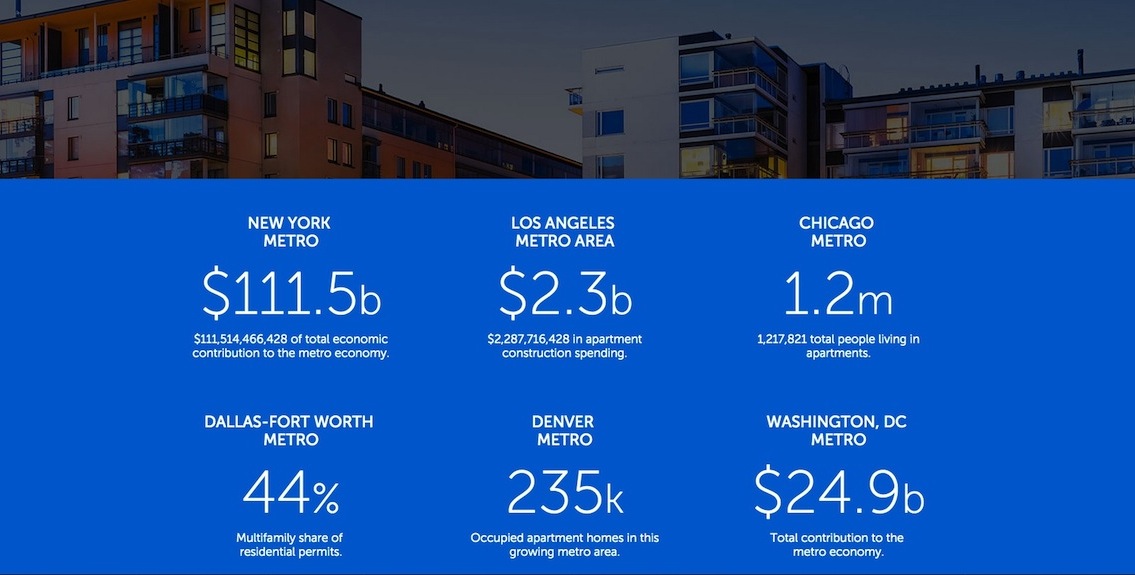The National Multifamily Housing Council and the National Apartment Association launched the latest phase of “WeAreApartments,” a marketing campaign that promotes the importance of the apartment industry to the U.S. economy.
Using research from George Mason University’s Center for Regional Analysis, the groups claim that there are more than 37 million Americans—12% of the population—living in just under 20 million apartment units nationwide. Apartments and their residents contribute $1.3 trillion annually to the economy through construction, property management, and other jobs the industry supports.
This research provides some interesting factoids about the apartment sector: For example, 49% are one-person households, compared to 24% of apartments with three or more people in them. The highest portion of apartment buildings—27%—has either 50 units or more, or a between five and nine units. The apartment housing stock is aging, too: more than half was built between 1959 and 1979.
The campaign contends that the country needs between 300,000 and 400,000 new apartments each year to keep up with demand.
Apartments contribute more to the New York metropolitan area’s economy—$111.5 billion annually—than in any other market. Multifamily accounted for 44% of residential permits issued in Dallas-Fort Worth last year. And $2.3 billion was spent on apartment construction in Los Angeles.
(The campaign’s website includes an Apartment Community Estimator, which allows metros and states to figure out the economic construction from the apartment sector in their respective areas.)
The campaign contends that the country needs between 300,000 and 400,000 new apartments each year to keep up with demand. “What construction has accelerated in response, many communities still lack sufficient housing options,” it reports.
To get its message out, the groups sponsoring this campaign have devised a new series of print and online ads that attempts to get beyond perceived stereotypes about apartment dwellers. For example, one ad shows a young African-American woman sitting in the kitchen of her apartment. The ad describes her as “Botanist. Swim Coach. Pickle Easter. Renter,” followed by the campaign’s tagline “Apartments. We Live Her.” Another ad states humorously that “Liberals Live In Them. So Do Conservatives, But In Another Wing.”
One of the campaign’s more provocative messages is that apartment dwellers are fulfilling their “The American Dream.” That phrase, heretofore, had been reserved for homeownership, but younger Americans’ avidity for owning a house is still uncertain.
Related Stories
| Oct 4, 2022
Rental property owners want access to utility usage data for whole properties
As pressure from investors for ESG reporting mounts, owners of multifamily properties increasingly look to collect whole-building utility usage data.
| Oct 4, 2022
In dire need of affordable housing, Aspen, Colo. will get a development that provides 277 affordable homes
A few miles from downtown Aspen, Colo., a development will provide 277 new affordable homes for an area experiencing a dire affordable housing crisis.
Green | Oct 3, 2022
California regulators move to ban gas heaters for existing buildings
California regulators voted unanimously recently on a series of measures that include a ban on the sale of natural gas-powered heating and hot water systems beginning in 2030.
| Oct 3, 2022
The College of the Holy Cross completes a $110 million performing arts center
In Worcester, Mass., a one-hour drive from Boston, the College of the Holy Cross has completed its $110 million Prior Performing Arts Center.
Resiliency | Sep 30, 2022
Designing buildings for wildfire defensibility
Wold Architects and Engineers' Senior Planner Ryan Downs, AIA, talks about how to make structures and communities more fire-resistant.
| Sep 30, 2022
Manley Spangler Smith Architects partners with PBK in strategic merger
Manley Spangler Smith Architects (MSSA), a Georgia-based, full-service architectural firm specializing in educational and municipal facilities, announced today a significant development aimed at increasing its capabilities, expertise, and suite of services.
| Sep 30, 2022
Lab-grown bricks offer potential low-carbon building material
A team of students at the University of Waterloo in Canada have developed a process to grow bricks using bacteria.
| Sep 29, 2022
FitzGerald establishes Denver office
The new location bolsters FitzGerald’s nationwide reach and capitalizes on local expertise and boots-on-the-ground to serve new and existing clients seeking to do business in Denver and the Front Range, as well as the Southwest United States, California, and Texas.
| Sep 28, 2022
New digital platform to foster construction supply chains free of forced labor
Design for Freedom by Grace Farms and the U.S. Coalition on Sustainability formed a partnership to advance shared goals regarding sustainable and ethical building material supply chains that are free of forced labor.
| Sep 27, 2022
New Buildings Institute released the Existing Building Decarbonization Code
New Buildings Institute (NBI) has released the Existing Building Decarbonization Code.

















